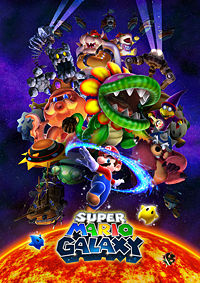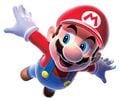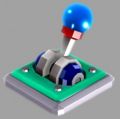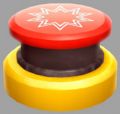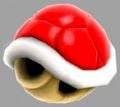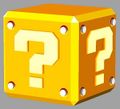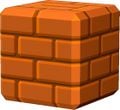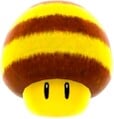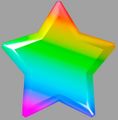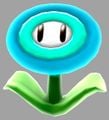Super Mario Galaxy
Template:Justreleased Template:Infobox
Super Mario Galaxy is the newest sequel to the series of Mario's 3-D platformers, after Super Mario 64 and Super Mario Sunshine. It uses parts of the cancelled Mario game for the GameCube, Super Mario 128. With 700,000 copies preordered in Japan, and 400,000 in the U.S., it is the most preordered Wii game to date.
Super Mario Galaxy, unlike other Mario games, takes place in outer space. Most of the game's levels consist of many planets, some big and some small, some flat and some round. The game contains 242 stars to collect (121 for Mario and 121 for Luigi).
Story
Every hundred years a comet passes over the Mushroom Kingdom and rains down magical stars and stardust. Princess Peach invites Mario to her castle to join in the festivities. As the citizens of the kingdom are celebrating the centennial event, Bowser attacks the Toads with his airships and freezes them in crystals. He "invites" Peach to his new galaxy and takes her castle up into space. When Mario tries to save her, Kamek shoots Mario far away. Mario later wakes up on a small grassy planet and meets a white Luma who escaped the castle at the last minute. The white Luma and two other Luma transform into Space Rabbits, who promise to tell Mario where he is if he catches them. When he does so, they take him to meet Princess Rosalina, who tells Mario that the Universe is in great danger after Bowser attacked Rosalina's ship, the Comet Observatory, and stole the Power Stars and the seven Grand Stars. Without these, the Comet Observatory is lost. Rosalina asks him to rescue the Grand Stars in order to defeat Bowser, who took Peach to the Center of the Universe. Mario then starts his journey across the Galaxies, freeing Grand Stars. Once six of the Grand Stars are collected, the Comet Observatory becomes a spaceship and takes Mario to the Center of the Universe. Here, he defeats Bowser in his central galaxy, retrieves the last Grand Star, and rescues Princess Peach. Without this Grand Star, the sun of Bowser's near-complete galaxy undergoes a supernova and creates a giant black hole. Everything in the universe begins to fall in, including the white Luma that accompanies Mario. The black hole becomes a huge tornado which soon explodes. Mario appears in front of Rosalina, who had somehow saved him from the cataclysm for a while. She tells him that this is not the end, but a new beginning for the universe, and that the universe is an endless cycle, but one that never repeats itself the same each time. Mario later awakens in the Mushroom Kingdom near Peach's castle. He sees everyone he's met throughout his adventure celebrating, while Bowser and Peach sit next to him. "Welcome to the new galaxy!" Mario exclaims, as the camera zooms out past the mushroom planet, revealing that the whole universe has been merged into one giant galaxy. and the game ends. After the credits, Rosalina and a group of Luma appear on the planet Mario started on at the beginning of the game. Rosalina says "I'll be watching you from the stars" and flies off in the Comet Observatory. Finally, the white Luma is shown to be alive, now living on the small planet.
Unique Features
Super Mario Galaxy has many brand-new features that no Mario game has ever had, one of which is the Star Cursor. The player can shake the Wii Remote and make Mario perform a Star Spin. The Star Cursor is also used to perform a variety of tasks, from climbing vines, to manipulating Wobble Launchers, to collecting Star Shards.
Unlike the last two titles, a Co-Op Mode is available, in which the second player controls a second Star Cursor. The extra Star Cursor, unlike the main one, can be used to freeze enemies in their tracks with a press of the A Button, so that Mario can defeat them easily.
The game features new items like the Star Ring, which allows Mario to launch off of a planet and go flying to the next. There is no warning that a boss might be located on the next planet, no indication that Mario may be facing something terrible or something peaceful on where he's headed next, and no loading screens or mission select screens for levels.
Manta Rays take the place of Bloopers from Super Mario Sunshine. Mario will ride them in a pair of mini-game race stages.
New enemies in this game include the Cosmic Bloopers and the Cosmic Bullet Bills. However, Mario meets new friends too, such as Cosmic Toads and Space Rabbits. Stars make a comeback, leaving Shine Sprites in the dust with their new orange-golden shine. The game will has the traditional goal of collecting 120 stars (first seen in Super Mario 64), though with the slight twist of an unlockable finale star at the end.
Additionally, Mario retains his ability to gain different abilities, via special mushrooms. Similar to Super Mario 64, in which he could obtain the Wing Cap and Metal Cap, Mario is able to collect suits, such as the Bee Suit and the Boo Suit, which allow him to transform into Bee Mario and Boo Mario, respectively. The Super Mushroom replenishes any lost health and adds a second health meter. Other powerups include the Spring Mushroom, Fire Flower, and Ice Flower. Also, the Cannon from Super Mario 64 returns.
The game also has a level intro for every star, as did Super Mario Sunshine. Similar to Princess Peach's castle in Super Mario 64, the Comet Observatory acts as the game's central area.
The game also contains side-scrolling levels with classic enemies such as Thwomps and Piranha Plants.
As in Super Mario Sunshine, Mario can jump on NPCs to gain extra height or annoy them.
It also features items and enemies that went absent in Super Mario Sunshine, including Goombas, Swoopers, the long jump, and Koopa shells.
Once the player beats the game and gains 120 stars as Mario, he or she can go back to Rosalina and ask to fight Bowser again. Once Bowser is re-defeated, the Player now has the option to play as Luigi. He is faster and jumps higher than Mario, but he has trouble stopping, making the game slightly harder. Once the player beats the game and collects 120 stars as Luigi, the 121st star becomes available.
Oddly, when playing through the game as Luigi, the stars that required Mario to meet Luigi still contain Luigi, so there are two Luigis in the game. Luigi ends up rescuing himself from the Haunted Mansion. Rosalina then calls the second Luigi Luigi's twin. They appear to be exactly the same. However, if one looks closely at them, one will notice the playable Luigi is wearing lighter green clothes and is shorter. It is unknown which is the normal Luigi.
Super Mario Galaxy contains a few different types of stars, including red, green, and comet stars. The green stars are to be secret stars which are used to unlock trial galaxies and the red stars appear when Mario uses a Red Star. The thirty comet stars are obtained by completing special challenges in the larger galaxies, such as speed runs, "daredevil" runs in which Mario only has one point of health, and missions where Mario must collect one hundred purple coins.
Bosses
Fifteen bosses are in the game.
- King Kaliente
- Megaleg
- Tarantox
- Dino Piranha
- Bugaboom
- Bowser Jr.
- Kamella
- Bowser
- Bouldergeist
- Baron Brrr
- Topmaniac
- Major Burrow
- Kingfin
- Undergrunt Gunner
- Mecha Bowser
Items
In Mario's new adventure, he uses many new items that give him moves he's never had before.
- Sling Pod
- Star Ring
- Pull Star
- Star Shard
- Boo Suit
- Star Chip
- Rainbow Notes
- Bee Suit
- Item Crystal
- Life Shroom
- Fire Flower
- Power Star
- Ice Flower
- Rainbow Star
- Sling Star
- Silver Star
- ? Block
- Koopa Shell
- Spring Mushroom
- Grand Star
Characters
Mario and Luigi encounter many characters in the galaxies.
- Mario
- Princess Peach
- Bowser
- Bowser Jr.
- Space Rabbits (New)
- Bees (New)
- Princess Rosalina (New)
- Queen Bee (New)
- Penguins
- Lumas (New)
- Manta Ray
- Luigi
- Cosmic Mario/Luigi (New)
- Guppy (New)
- Gil Board (New)
- Gearmos (New)
- Spooky Speedster (New)
Confirmed Enemies
New Enemies
- Cosmic Bloopers
- Cosmic Tox Boxes
- Chomp Heads
- Boulders
- Swoopin' Poinks
- Mandibugs
- Gringills
- Cosmic Scuttle Bugs
- Pumpkin Heads
- Topman
- Bomb Boos
- A giant jellyfish-like creature.
- Red F.L.U.D.D. head
- Blue F.L.U.D.D. head
- A blue crab.
- Astro Goombas
Returning Enemies
- Whomps, Thwomps, Thwimps, Mad Pokeys
- Both Magikoopas and Dry Bones make their debut in a 3-D platformer.
- Mecha-Koopas
- Bloopers
- Koopas
- Goombas
- Grand Goombas
- Bob-ombs
- Pokeys
- Boos
- Swoopers
- Wigglers
- Banzai Bills
- Preying Mantases
- Piranha Plants. There is also a kind of Piranha Plant that is purple in color with a spiky stalk, and harder to defeat.
- Cheep-Cheeps
- Urchins
- Pushy Walls
- Tweesters
- Firebars
- Bullet Bills
- Torpedo Teds
- Rocky Wrenches
- Cataquacks
Galaxies
Some galaxies can be accesed from domes, like the Terrace which leads to certain galaxies. These domes are found in the Comet Observatory, where new areas become accessable as Mario gains Grand Stars.
The Gateway to the Starry Sky
Hungry Luma
The Terrace
Hungry Luma
The Fountain
Hungry Luma
The Kitchen
Hungry Luma
The Bedroom
- Gusty Garden Galaxy
- Freezeflame Galaxy
- Dusty Dune Galaxy
- Honeyclimb Galaxy
- Bowser's Dark Matter Plant
Hungry Luma
The Engine Room
Hungry Luma
The Garden
Hungry Luma
The Center of the Universe
The Trial Galaxies
The trial galaxies are slightly more difficult from the other galaxies
The Grand Finale
Prankster Comets
There are five types of comets that randomly appear and cause special occurences in the galaxies. These special missions yeild many additional power stars.
- Speedy Comet: Mario must complete the level within a certain time limit.
- Daredevil Comet: Mario must complete the level with only one health.
- Cosmic Comet: Mario must race Cosmic Mario to a star.
- Fast Foe Comet: All enemies in the level are sped up.
- Purple Comet: Only available after the game is beaten, Mario must collect 100 purple coins to get a star.
Mini-Games
- Bubble Blowing
- Manta Ray Surfing
- Rolling Ball
- All three can be found in the trial galaxies
Reception
Famitsu Magazine has given Super Mario Galaxy a score of 38/40. (This means two reviewers gave it a nine, and two gave it a perfect ten.) To put that in perspective, Super Mario Sunshine was given 37/40 and Super Mario 64 39/40. The Official Nintendo Magazine UK gave the game 97%, but Donkey Kong Country 2 and Super Mario World 2 got 98% in past issues of Official Nintendo Magazine. It was called the best game of the decade and praised for having excellent graphics, sound and gameplay as well as a mixture of new features and classic features.
Forms
Mario has many forms in this game, like Flying Mario.
Artwork
- Galaxy BossesArtwork.jpg
Mario and Bosses
- Galaxy MarioArtwork 00003.jpg
Mario Star Spinning
- Tykemario.jpg
Mario and a Luma
- Galaxy MarioArtwork 00001.jpg
Mario Soaring with a Luma
- BeeMario.jpg
- BooMario.jpg
- Ice Mario.jpg
- SMG RainbowMario.jpg
- Springmario.jpg
- BowserSMG.jpg
- BowserJr.SMG.png
- PrincessRosetta.jpg
- Toadsmgartderf.PNG
- Kamekkoopamagickblurpartsmg.PNG
- QueenBee.jpg
- Offwhitestarsmg.PNG
White Luma
- Yellowstarsmg.PNG
Yellow Luma
- Bluestarsmg.PNG
Blue Luma
- Redstarsmg.PNG
Red Luma
- Greenstarsmg.PNG
Green Luma
- Blackorbrownstarsmg.PNG
- Mantastar.jpg
- Rollstar.jpg
- Steponblock.jpg
- LifeShroom.jpg
- Upshroom.jpg
- Greenshootshell.jpg
- UnbreakableBlock.jpg
- Questioningcoin.jpg
- SMG SpringMushroom.jpg
- SMG BooSuit.jpg
- SMG FireFlower.jpg
Trivia
- Bowser uprooted Peach's castle once before, in Paper Mario, but only lifted it into the sky, and it's unknown if it was Outer Space in that game, it was dark.
- This is one of the only two Mario games where Bowser displays the power to create electricity. The other is Hotel Mario. However, the Bowser suit in Luigi's Mansion also had the ability to create electricity.
- In one of the galaxies, if you feed a Hungry Luma, he will transform into a planet shaped like Yoshi's head.
Similarities to Other Games
Super Mario Galaxy has many similarities to previous games.
- Like the beginning of Super Mario 64, this game's opening features a letter from Peach to Mario, read aloud by the princess.
- The Comet Observatory works in the same way as Princess Peach's Castle in Super Mario 64 and Delfino Plaza in Super Mario Sunshine.
- The Power Stars return from Super Mario 64 and Super Mario 64 DS, after an absence in Super Mario Sunshine.
- Surfing 101 and The Galaxy's Greatest Wave have the same functions as Super Mario Sunshine's Ricco Harbor minigame Blooper Safari, with the Manta Ray replacing the Blooper.
- The Blooper sub-species Cosmic Blooper bears a strong reseamblance too Shroobs and Shroobifiead enemies of Mario & Luigi: Partners in Time
- A Giant Goomba must be fought in the beginning of the game; this Goomba is almost identical to the boss Mega Goomba of World 4 of New Super Mario Bros.
- Silver Stars returns from Super Mario 64 DS
- The boss Dino Piranha has strong reseamblances to another Piranha Plant-boss; Petey Piranha
- The beta Super Mario Galaxy featured Cosmic Toads who looks a bit like the Starshade Bros. from Mario & Luigi: Superstar Saga
- Sweet Sweet Galaxy plays a remix on the map theme from Super Mario Bros. 3, and is also similar to the Secret Stages where Shadow Mario takes F.L.U.D.D.
- The Airships returns from Super Mario Bros. 3, with their theme taken from the same game
- The die/Game Over screen themes is a remix of the die/Game Over theme from Super Mario Bros.
- That Luigi first is found in a giant Ghost House filled with Boos MAY be a reference to Luigi's Mansion
- The "Grand Star taken" posé looks like his "Star" posé from Super Mario RPG: Legend of the Seven Stars
- In the Good Egg Galaxy, steel blocks from Super Mario Bros. 3 reappear
- An 8-bit Mario appears in the Toy Time Galaxy.
- Collecting several Music Notes plays different themes from Super Mario Bros.
- The first two Bowser levels plays a remix of the Bowser theme from Super Mario 64
- The Galaxy-screen Select resembles a map from the StarFox-series
External Links
Template:Galaxies Template:Domes Template:Terrace Template:Fountain Template:Kitchen Template:Bedroom Template:Engine Room Template:Garden
